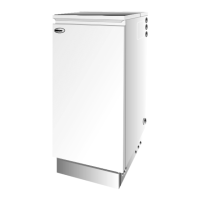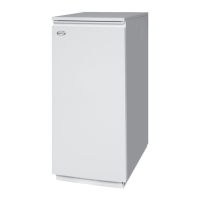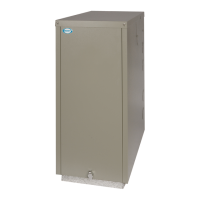30
3 Pellet Specification, Storage
and Delivery
3.1 Pellet Specification
Grant Spira boilers are designed to ONLY run on EN Plus Grade A1 wood pellets that comply with BS EN ISO 17225-2:2014 and meet
the following criteria. Failure to use approved pellets will invalidate the product guarantee.
The following terms are commonly used when describing the properties of wood pellets:
Additives Additives are used to improve the stability of the pellets. If manufactured correctly, and of a sufficiently low
moisture content, quality pellets will require no additives.
Ash Ash represents the non-combustible content of the pellet. Higher ash content reduces the calorific value of
the pellet and requires the appliance to be cleaned more frequently.
Average length To provide a predictable flow of fuel into the burner, the recommended length of a pellet is between 3.15
and 40mm.
Bulk density Bulk density is the ratio between the weight of the pellet and the amount of space they take up. A good
quality pellet will have a density of 650 kg/m
3
.
Chlorine High levels of chlorine in the flue gases emissions can give rise to corrosion.
Diameter The most common diameter is 6mm with some 8mm also available. This boiler is designed for 6mm only.
Fines Pellets are made from compressed wood. As pellets rub together they can break down slightly, producing
dust or fines. Too many fines indicate a poor quality pellet and can impede pellet flow in addition to
causing dust problems when delivering and storing the pellets.
Mechanical durability This is a measure of how stable the pellet is and how likely it is to produce fines from normal handling.
A high durability percentage is an indicator of a good quality pellet.
Moisture content Moisture affects the calorific value of the pellet. Low moisture content guarantees constant and predictable
combustion efficiency. Higher moisture contents can result in pellet breakdown.
Net Calorific Value This is the useful energy contained in a kilogram of fuel. This value is affected by the amount of non-
combustible materials (ash) and the moisture content of the pellet. Typical values range from 4.8 kWh/kg
to 5.2 kWh/kg.
Nitrogen and Sulphur High levels of Nitrogen and Sulphur in the flue gases emissions can give rise to corrosion.
Property class Unit Limits as per BS EN ISO 17225-2
Origin and source 1.13 Stemwood
1.2.1 Chemically treated wood residues
a
Diameter (D) mm 6 ± 1
Length (L) 3.15 < L ≤ 40
Moisture (M) w-% ≤ 10
Ash (A) w-% dry ≤ 0.7
Mechanical durability
(DU)
w-% ≥ 97.5
Fines (F)
b
w-% ≤ 1.0
Additivies
c
w-% ≤ 2
Type and amount to be stated
Net calorific value (Q) MJ/kg or ≥ 16.5
kWh/kg ≥ 4.6
Bulk density (BD)
d
kg/m
3
≥ 600
Chlorine (Cl) w-% dry ≤ 0.02
Footnotes
a
Negligible levels of glue, grease
and other timber production additives
used in sawmills during production of
timber and timber product from virgin
wood are acceptable, if all chemical
parameters of the pellets are clearly
within the limits and/or concentrations
are too small to be concerned with.
b
At factory gate in bulk transport (at
time of loading) and in small (up to
20kg) and big bags (at time of packing)
or when delivering to end-user.
c
Type of additives to aid production,
delivery or combustion.
d
It is recommended actual value of
bulk density to be stated.
3.2 Biomass Suppliers List
The Biomass Suppliers List (BSL) is a list of suppliers of wood fuel who have been accredited as demonstrating that their fuel meets
the sustainability criteria required under the RHI.
Recipients of the Domestic RHI will be obliged to source their fuel from suppliers on the BSL unless they are supplying
themselves. To find an approved supplier in your area go to www.biomass-suppliers-list.service.gov.uk/find-a-fuel

